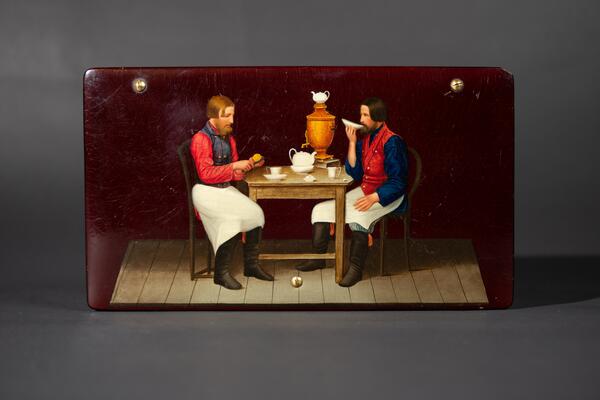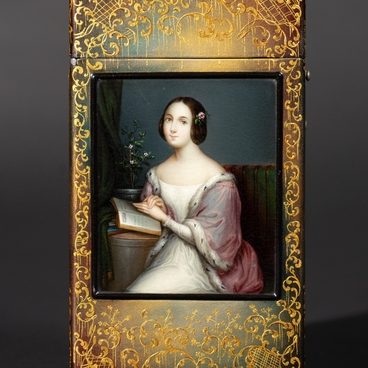The second half of the 19th century was the heyday of Russian genre painting. Genre painting is a form of genre art which depicts ordinary scenes from everyday life of an era; masters outline characteristic details of everyday life and the most typical features of their contemporaries.
After the abolition of serfdom in 1861, Russian art more and more often turned to national themes and traditional folk culture. The main hero of such works was a simple man and his surroundings. Artists working within the folk theme depicted different types of street vendors and various village scenes that the public loved: Russian dances, peasant families, winter and summer troikas (carriage drawn by three horses), tea drinking. They were very popular and eventually became a classic of Lukutin lacquer miniature.
The Lukutins paid great attention to the artistic quality of their products. They bought subscriptions for their artists to the magazines ‘Niva’, ‘Ogonyok’, ‘Art Leaflet’, and the masters copied images from them using tracing paper.
The composition ‘Tea Drinking’ by the Lukutin factory masters was probably copied from a photograph by Johann Manstein published in the magazine ‘Niva’. It was repeated many times on the factory products in different versions. The miniature displayed in the museum is one of them.
The composition of the painting is quite simple: two clerks from a merchant shop slowly drink tea. There was also a third figure in the photo — a tavern waiter. But he was not depicted in the lacquer painting.
The box ‘Tea Drinking’ is a vivid example of folk-themed genre painting. The composition on a dark cherry background is characterized by simplicity and harmony. The red color of the clerks’ shirt and vest, so beloved by the people, is contrasted with the white color of the aprons and dishes on the table.
The artist portrayed the characters with convincing realism, giving each man his own character and appearance. Their lively faces, detailed clothes and the overall conciseness of the composition helped to create a simple and sincere image.
This plot was repeated more than once on various products of the Lukutin factory and Vishnyakov lacquer workshops: clerks were painted on boxes, teapots, paperweights, matchboxes. The beloved image was also differently interpreted by miniature painters of the 20th century. They reflected in their lacquer paintings the features of the new way of life.
After the abolition of serfdom in 1861, Russian art more and more often turned to national themes and traditional folk culture. The main hero of such works was a simple man and his surroundings. Artists working within the folk theme depicted different types of street vendors and various village scenes that the public loved: Russian dances, peasant families, winter and summer troikas (carriage drawn by three horses), tea drinking. They were very popular and eventually became a classic of Lukutin lacquer miniature.
The Lukutins paid great attention to the artistic quality of their products. They bought subscriptions for their artists to the magazines ‘Niva’, ‘Ogonyok’, ‘Art Leaflet’, and the masters copied images from them using tracing paper.
The composition ‘Tea Drinking’ by the Lukutin factory masters was probably copied from a photograph by Johann Manstein published in the magazine ‘Niva’. It was repeated many times on the factory products in different versions. The miniature displayed in the museum is one of them.
The composition of the painting is quite simple: two clerks from a merchant shop slowly drink tea. There was also a third figure in the photo — a tavern waiter. But he was not depicted in the lacquer painting.
The box ‘Tea Drinking’ is a vivid example of folk-themed genre painting. The composition on a dark cherry background is characterized by simplicity and harmony. The red color of the clerks’ shirt and vest, so beloved by the people, is contrasted with the white color of the aprons and dishes on the table.
The artist portrayed the characters with convincing realism, giving each man his own character and appearance. Their lively faces, detailed clothes and the overall conciseness of the composition helped to create a simple and sincere image.
This plot was repeated more than once on various products of the Lukutin factory and Vishnyakov lacquer workshops: clerks were painted on boxes, teapots, paperweights, matchboxes. The beloved image was also differently interpreted by miniature painters of the 20th century. They reflected in their lacquer paintings the features of the new way of life.



